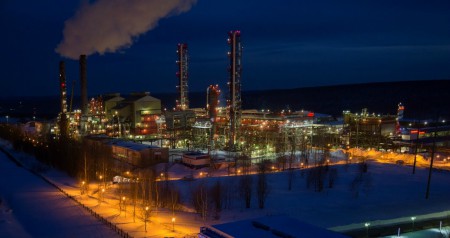MHI to license CO2 capture technology to Russian chemical company
TOKYO — Mitsubishi Heavy Industries, Ltd. (MHI) has concluded an agreement to license technology for its flue gas carbon dioxide (CO2) capture plant to PJSC Metafrax, a major Russian chemical company. Metafrax will use recovered CO2 to produce ammonia, urea, and melamine from the byproducts of a methanol plant. The plant will provide recovery capacity of 1,200 tpd, and will be installed at a facility in Perm, located on the western side of the Ural Mountains, scheduled for completion in 2021.
 |
| PJSC Metafrax. |
MHI received the order through Casale SA, a Swiss engineering firm, which obtained a contract from Metafrax for engineering, procurement and construction management (EPCm) of the overall ammonia production, CO2 capture, and urea and melamine production facilities. MHI will grant a technology license for CO2 recovery technology to Casale SA, which will sublicense it to Metafrax.
Ammonia will be synthesized by combining surplus hydrogen from the existing methanol plant with nitrogen from a newly constructed air separation plant. Urea and melamine will be then produced from CO2 recovered from flue gas emitted by the methanol plant. The facility will have capacity to produce 894 tpd of ammonia, 1,725 tpd of urea, and 40,000 tpy of melamine.
Metafrax was established in 1955 in Perm, a major industrial city in the western Ural region. The company is the largest producer of methanol in Russia, with current production capacity of 3,375 tpd, an increase of 35% from 20 yr ago.
MHI's flue gas CO2 capture technology, known as the "KM CDR Process," uses an advanced absorption solvent (KS-1) jointly developed with Kansai Electric Power Co., Inc. to achieve substantial reductions in energy consumption compared with earlier methods. Since 1999 this technology has been adopted at 13 plants worldwide to capture CO2 from flue gases of steam reformers and boilers fired by natural gas, heavy oil or coal at chemical plants. This track record has made MHI the definitive global leader in commercial applications for CO2 capture plants.
In addition to the production of urea, MHI's flue gas CO2 capture technology can be used for a wide range of applications, including chemical applications such as production of methanol and dimethyl ether (DME), capture and storage of CO2 generated by thermal power plants and other facilities, and enhanced oil recovery (EOR), a method of increasing crude oil production by injecting CO2 into oil reservoirs with declining productivity.
Going forward, MHI will continue to make contributions to sustainable economic development and environmental protection through proactive efforts to further its advanced CO2 capture technology.

- ExxonMobil halts 1-Bft3d blue hydrogen project in Texas
- Aramco and Yokogawa commission multiple autonomous control AI agents at Fadhili gas plant
- Ukraine will resume gas imports via Transbalkan route in November
- Mitsubishi to inject $260 MM into Brunei LNG project
- Freeport LNG (U.S.) on track to take in more natgas on Thursday after unit outage



Comments